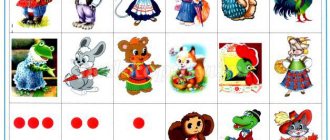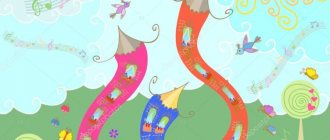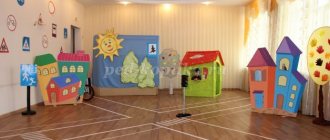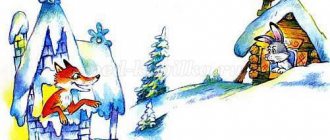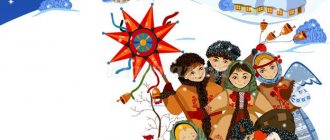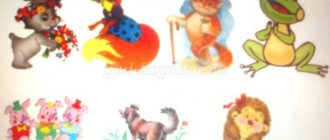Subject. Game-dramatization based on the fairy tale “Teremok”
Tasks:
1. Learn to distinguish and convey intonations and characters of fairy-tale characters.
2. Develop expressive speech, facial expressions, and movements in children.
3. To cultivate in children an interest in folk art and a desire to play fairy tales.
Equipment:
head attributes for a frog, mouse, hare, bear, wolf, fox, a small house made from a large cardboard box so that all children can fit in.
Roles:
Mouse, Frog, Hare, Fox, Wolf, Bear, storyteller - teacher (this will make it possible to direct the game and control it).
Lesson plan:
Greetings:
Children greet each other. The teacher uses a magic wand to turn everyone into forest animals, and calls each child a certain name, taking into account his individual characteristics. After this, all the children greet each other again, as good animals could do, conveying the greeting with intonation and expressive movements.
Warm-up:
Riddles about wild animals.
| In summer he walks through the forest, in winter he rests in a den. (Bear) | Gray, flannelette animal, clubfooted, long-eared. Well, guess who he is, and give him a carrot. (Hare) |
| The tail is fluffy, the fur is fleecy, he lives in the forest, he steals chickens in the village. (Fox) | Who walks around angry and hungry in the cold winter? (Wolf) |
Main part
Org. moment
: “One, two, three, fairy tale, open the door.” The teacher begins to tell that wonderful animals live in the magical forest. They live together in their little house. Only the wolf was not friends with them and did not visit them.
1. The teacher offers to make friends with the wolf and invite him to visit his little mansion.
2. Preparation of the game environment (teremok) and distribution of roles.
3. Children (animals) agree on how to invite the wolf to visit, what to treat him with, what to give him.
4. They go to his house and invite him to visit him.
4. Tea drinking in the mansion. The storyteller (teacher) supports communication between children.
5. It is proposed to play a game. “Let’s make some noise and keep quiet.” Children stand in a circle. Teacher “Let’s shout and make some noise together as loudly as possible. How can. Now let’s listen to ourselves: is noise pleasant? It's fun? Scary? Children may have different reactions to noise manifestations. For a child, noise is an important signal that the world is alive, that I exist. Allowing your child to make noise in a safe situation can help reduce his anxiety levels. Then the command “be silent” is given, but it does not imply listening to silence. The child must hear his own fears or pleasures, come into contact with the reactions of others.
6. General dance of joy. Children dance a cheerful round dance, including pair interaction, movements for right-left coordination.
Relaxation:
Exercise “Rest in the clearing.” Pleasant music plays, children lie down on the carpet, close their eyes and imagine themselves in nature. The sun is shining tenderly, the breeze is blowing. Flowers smell pleasant, butterflies flutter silently. Pause. Then the teacher touches the children with a magic wand and says that they are no longer heroes of a fairy tale, but boys and girls. Everyone wakes up, opens their eyes, gets up and says goodbye to each other.
Parting:
“One, two, three, fairy tale, close the doors.” Children say goodbye to each other.
Preliminary work:
Reading the fairy tale “Teremok”, “Mitten” and discussing the characters.
Preparing attributes for the game.
Theme "Sailors"
Tasks:
1. Introduce children to the roles: boatswain, captain, sailors.
2. Encourage the desire to change role behavior in accordance with different game situations.
3. Teach children actions with imaginary objects, substitute objects.
4. Develop the ability to listen to each other, ask for help, give reasons for your actions and explain them.
Equipment:
Caps, steering wheel, anchor, walkie-talkie, captain's white cap, binoculars, substitute items.
Roles:
the captain is a teacher, the boatswain is an active child, the doctor, the cook, the sailors are children.
Lesson plan:
Greetings:
Children greet each other. The teacher asks “How can you make another person happy?” The children’s answers are listened to. (You can try to make him laugh, stroke him, say kind words to him, smile) “Children, look, smile into each other’s eyes and give joy.”
Warm-up:
Riddle: “There is no vest without stripes, He who wears a vest is ... (sailor).
Main part
Org. moment:
"Attention attention!!! An SOS signal has been received. The ship "Brave" is wrecked in the Barents Sea. Let's hurry to the rescue!
1. The teacher takes on the role of captain and puts on a white cap. Together with the children, he prepares equipment for the game, using large building materials and modules.
Captain: "We're raising anchors
And we sail overseas.
The sea is calling, the wind is singing.
Go ahead, friends, go!”
2. The teacher-captain reminds children of the functions of a navigator - he leads the ship, using the instruments on the ship - a compass, a walkie-talkie. Bosun - keeps order on the ship and helps the captain. Everyone follows the captain's commands.
3. The captain gives commands: “release anchor”, “raise anchor”, “starboard”, etc. He speaks on the radio, communicates with the boatswain, and conducts appropriate dialogue with the sailors.
4. Completing an urgent task. The ship reaches the shipwreck of the Bold. The captain gives the command: “There are people on the right side,” “lower the boats overboard.” Brave sailors save drowning people, the doctor provides them with medical care, and the cook feeds them lunch.
5. The captain invites everyone to rest after a hard day.
Relaxation:
Exercise “Dream on the seashore” Children listen to the sound of the sea.
The teacher tells the children that they all have the same dream and tells its contents. Children see in their dreams what they did in class (consolidating the impressions and skills gained). Pause. The teacher tells by what signal the children should wake up (counting when the bell rings). Pause. The signal sounds. The children calmly get up and say goodbye .
Parting:
Preliminary work:
Conversation on the topic: Brave team.
Reading: V. Mayakovsky: “This is my little book about the seas and about the Lighthouse”, V. Korzhikov “Swimming through the menacing waves”, L. Kassil “Far into the sea”, S. Sakharov “The sea is agitated”.
Lesson summary for the senior group “dramatization game based on the fairy tale “Teremok”
Game-dramatization based on the Russian folk tale “Teremok”
Description of material
: summary for children of the senior group “Game-dramatization based on the Russian folk tale “Teremok”. This is a summary of the educational field “Socialization”, aimed at developing children’s interest in theater, developing a culture of speech, emotionality and nurturing a culture of behavior in public places.
Educational areas: “Socialization”, “Communication”, “Cognition” “Music”, “Reading fiction”.
Goal: To teach children to dramatize a familiar work;
introduce children to riddles - rhymes;
consistently carry out the events of the fairy tale, coordinate your actions with the actions of your partner;
cultivate a love of folk art.
Methodological techniques: conversation, role-playing game “I’m going to the theater”, didactic game “Say a Word”, dramatization game, animal dance, summing up.
Activation of the dictionary: theater, artists, tickets, controller.
Equipment and materials: toys of characters from the fairy tale “Teremok”, decorations of the tower (house), trees; caps, masks of fairy tale heroes; cards depicting fairy tale heroes; wonderful chest; musical accompaniment.
Progress of the lesson
On the table there is a model of a mansion, next to it is a magic chest.
- What a beautiful chest, I wonder what’s in it? (tries to open it, but it doesn’t open) Maybe a fairy tale? The fairy tale is hidden in a riddle. Well, try to guess. If the answer is correct, the fairy tale will come to us again.
- The animals lived in that house,
But the bear broke their house,
He couldn't get into it...
This is a fairy tale... (teremok)
- That's right, look, the chest has opened, let's see what
there? A fairy tale, but what kind, let's try to guess again.
Didactic game “Say the Word”
Target:
introduce children to rhymes - riddles; develop a sense of rhyme. Children finish the last word in rhyme.
- She looked slyly, waved her tail and disappeared - miracles. Where are you, red... (put out the toy).
— In the meadow, leaves are jumping over the hummocks. Protruding eyes and crooked legs. But where are the ears, who is it... (put out the toy)
- Oh, the bunnies are not amused by his fangs and fur. Since childhood he knows a lot about hares, the evil, toothy gray one... (put out the toy)
- Who is big and club-footed and took the honey out of the hive with his paw? I ate the sweetness and started crying. What is his name... (put out the toy)
— Guys, what fairy tale unites the house and these toys? (suggested answers)
Conversation based on a fairy tale.
- Please remember what the heroes of the fairy tale did? (suggested answers)
- Which of the animals was not allowed into the tower?
- Remember what the fairy tale heroes said when they knocked on the door of the mansion? (suggested answers)
—
- What do you guys think, can we show you such a fairy tale? (children's answers)
To do this, we need to go to the theater, become artists and spectators.
Role-playing game "I'm going to the theater."
Target:
To consolidate children's knowledge about the rules of conduct in the theater, to expand children's understanding of the professions of theater workers.
-Here, here at the box office, there are tickets, you need to buy them. The price for the ticket will be politeness. Anyone who is not polite will not be given a ticket.
The cashier sits down at the table. Every child says:
- “Please give me a ticket.”
Then he says, “Thank you.”
Controller enters:
-I'm a controller. I'm checking the tickets.
Look at your tickets, those who have fairy-tale characters drawn become artists, and you and I will be spectators. Now artists, go get ready for the performance. And the guys and I will talk a little about the rules of conduct in the theater.
Conversation and viewing of the presentation “How to behave in the theater”
- Now sit down, the guys will show you the fairy tale “Teremok”.
Dramatization of a fairy tale
(the fairy tale should end with the words “The little mouse, the frog, the runaway bunny, the little fox-sister, the gray-barrel spinning top, all safe and sound, barely managed to jump out of it”)
- Well done, you all coped with your role. The guys were artists and the guys showed a fairy tale. The artists were very good. Let's give them a big clap
-Guys! Did you like the fairy tale? How? (Children share their impressions.)
“But for some reason, I felt bored because the little tower fell apart.” How do you think we can help our fairy-tale heroes (suggested answers)
- Children have plenty of rest. Quickly, quickly, everyone, get up. (To the accompaniment of a Russian folk song, children build a new tower from modules.)
— There is a little mansion in the field, a little mansion, it’s very, very tall, oh, tall. You can’t live without fun here, friends live in the mansion!
The animals line up in one line, and everyone says together:
- In the little house we will live and be close friends. Together we will work, we will sing and have fun! (Perform animal dance)
Children clap for the artists.
- Take off your hats and masks, and now you guys are again, you’re great, you portrayed animals better than anyone else.
— Children, did you like the fairy tale?
— What did you like most? Next time we will watch a different fairy tale. See you soon in our theater.
